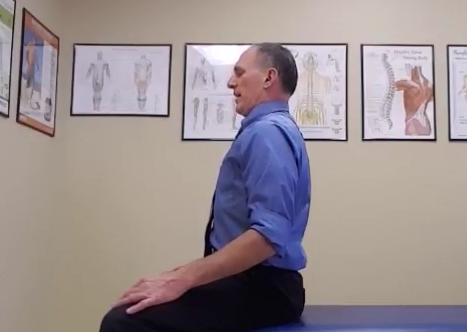Train smarter and target specific muscle groups to correct common postural flaws. Posture is defined as the carriage of the body as a whole. Proper posture ensures good motion and displays physique symmetry and balance.
Two types of postural faults exist. Structural and functional. The origin of structural faults are skeletal. Examples includes: one femur bone being longer than the other and two vertebrae being congenitally fused. Skeletal faults can’t be corrected. Develop an exercise plan to limit the impact of structural postural flaws.
Functional postural flaws are muscular in origin. Most functional posture faults are acquired due to strength imbalances. Generate a training routine which restores muscular strength balance between antagonist muscle groups. Target the weaker muscles with strengthening exercises while stretching the stronger opposing muscles.
Analyze posture with a sharp eye. Determine faults and devise a training plan to correct these flaws.
View your posture in standing, sitting and lying positions. Analyze how your body moves. Often times slight strength imbalances are more apparent during motion. Examine gait for abnormal movement patterns.
Formulate a quality training routine with the valuable information collected during your comprehensive postural evaluation. Train to decrease the negative impact of strength imbalances. Exercise to restore proper strength balances and improve posture.
Upper Body: Forward rolled shoulders, forward head carriage, scapulae moved away from the spine and a hunched upper back are common upper body postural imperfections. This poor posture is named Upper Cross Syndrome (AKA Upper Crossed Syndrome). Strength imbalances between the anterior shoulder muscles and the posterior shoulder muscles are the source. Train to correct shoulder strength imbalances and upper body posture will improve.
Forward rolled shoulders result when the muscles that attach to the front of the shoulder overpower and inhibit the muscles which pull the shoulder backward. The pectoralis minor, pectoralis major, latissimus dorsi and subscapularis muscles possess a biomechanical advantage over the posterior rotator cuff muscles, rear deltoid, rhomboids, middle trapezius and lower trapezius.
The biomechanical advantage combined with disproportion usage is the genesis of the strength imbalance and poor posture. Correct this postural flaw by stretching the anterior shoulder muscles and strengthening the muscles which pull the scapulae and shoulders backwards.
Utilize scapular retraction, inverted rows, cleans and kettlebell swings to strengthen the scapular retractors. Perform reverse flyes to develop the posterior deltoid. Execute the reverse pitch with precision to build strength and coordination in the posterior rotator cuff muscles.
Cervical Spine: Forward head carriage occurs when the muscles in the anterior neck overpower the posterior neck muscles. The sternocleidomastoids (SCM’s) are anterior neck muscles that contract bilaterally to protract the neck forward. Often times we protract the neck forward while straining with heavy weights, performing finer tasks or to see better.
Over time the anterior neck muscles become stronger than the posterior neck muscles. The strength imbalance leads to forward head carriage. Correct forward head carriage by developing strength in the posterior neck and upper back muscles.
Incorporate simple exercises like cervical retractions along with exercises which pull the shoulders backwards for best results. Work to hold the neck in line with the spine while straining.
Thoracic Spine: Increased thoracic kyphosis, or hunched back, often occurs along with forward head carriage and forward rolled shoulders. Combat upper body postural imperfections by strengthening the muscles that extend the midback, retract the scapulas and retract the neck. Strengthen the entire posterior chain and stretch the chest, ribcage and anterior shoulders to improve upper body posture.
Lumbar Spine and Pelvis: Common lumbar spine and pelvic shifts include forward titled pelvis and increased lumbar lordosis. Quite often these two postural flaws occur concurrently. This postural condition is named Lower Cross Syndrome (AKA Lower Crossed Syndrome.)
Strong lumbar muscles and strong hip flexors are a necessity. If the gluteal muscles and the abdominal muscles lack strength, the powerful hip flexors will pull the anterior pelvis downward. A strength imbalance between strong hip flexors and lumbar spine muscles versus undeveloped gluteal and abdominal muscles causes’ anterior pelvic tilt and increased lumbar curvature.
Strengthen the core with a plethora of quality exercises. Develop the glutes using pelvic bridges, reverse hypers, lunges and squats with various stances. Train these two muscles groups to work in synergy by utilizing fitball planks and functional kettlebell training.
Stretch the powerful hip flexors and lumbar muscles. Employ partner assisted stretches to further help improve your posture.
Lower Body: Common functional lower body postural faults include foot hyperpronation, knock knees and knee hyperextension. The feet are our standing, walking and running foundation. Strong feet are imperative for good posture. If the foundation is not solid the areas above it suffer.
Foot hyperpronation occurs when the feet roll too far inward while weight bearing. The result is flat feet, knock knees and an increased possibility of shin splints, plantar fasciitis and iliotibial band syndrome. Build foot strength with exercises that raise the longitudinal arch. Perform foot strengthening exercises such as the towel toe grab, short foot exercise and toe splaying/toe curling to improve foot function and posture.
Target the overpowered muscles with strength building exercises to eliminate posture flaws. Perform a thorough postural analysis and devise an intelligent training plan. Correct functional postural imperfections with a well-thought out routine and dedicated training.
Dr Donald A Ozello DC of Championship Chiropractic in Las Vegas, NV
Web Site: http://www.championshipchiropractic.com/
Blog: https://www.championshipchiropractic.com/wordpress/
YouTube: https://www.youtube.com/user/drdozellodc/videos
Twitter: https://twitter.com/drdozellodc
Facebook: https://www.facebook.com/Championship-Chiropractic-280141628688300/
LinkedIn: https://www.linkedin.com/in/dr-donald-a-ozello-dc-716b3233
“Running: Maximize Performance & Minimize Injuries” https://www.amazon.com/Running-Performance-Chiropractors-Minimizing-Potential/dp/1493618741
**Disclaimer: Always consult a medical professional before beginning an exercise program. Always work within your capabilities. Never perform an exercise that elicits or increases pain or symptoms. Reading this article and viewing the linked videos does not take the place of seeing a medical professional. Please visit a medical professional for evaluation, diagnosis & treatment.

